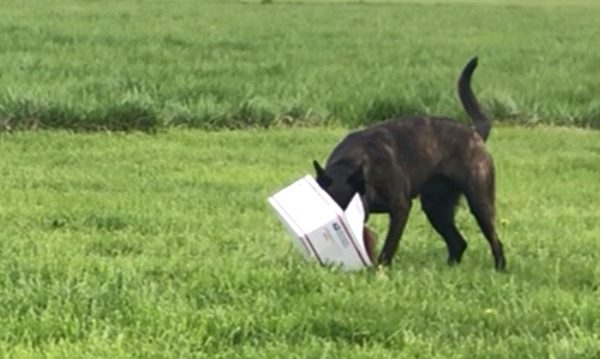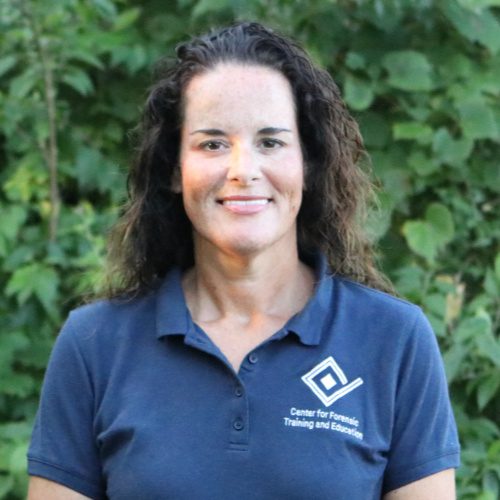No! Don’t Touch That! (Stopping Unwanted Behaviors At Source)

This week we are going to focus on a topic chosen by you! We received several requests asking what to do if your dog picks up, rolls on, tries to eat, digs at, marks, or otherwise disturbs source?
While this is a common problem, it is a serious one. You absolutely do not want to be on a scene and have your dog damage evidence or remains!
Why This Happens?
These are complex but resolvable issues. First let’s take a look at WHY these behaviors may be happening.
Did you rush through your initial training phases or perhaps missed a foundation step?
If you didn’t spend enough time on the basics, your dog may have chosen their own rules to the game.
Maybe you didn’t do enough repetitions on odor recognition/imprinting. We can’t stress this enough; odor imprinting and odor recognition is CRITICAL! This is the time where you solidify the target odor you want the dog to find and reinforce this behavior with the reward.
Did you take the time to truly identify what the dog prefers as a reward? We often see dogs that find odor more interesting or valuable than the reward. You may have decided that the dog has to be rewarded with a tug but maybe your dog prefers food. If you continue to present a reward that is not valuable to the dog then it may lead the dog to self-rewarding by picking up, rolling on, or digging at the source. You must make not only the reward, but the reward event itself (a game of tug, praise, fetch), more fun and engaging than the source.
Is it a break down in the performance of the trained final response itself? This can occur if you did not take enough time when you initially paired the trained final response with the target odor. You may have moved too quickly and started asking for the response without spending the time to make sure the command was completely understood under various conditions; indoors, outdoors, on different surfaces, etc. This issue can also arise when you have previously rewarded sloppy behavior. For example, if the trained final response is a sit and you have rewarded a half-sit.
It may seem boring or like you are moving too slowly. However, if you do not spend enough time building a strong foundation so that the dog clearly understands target odor, what to do when it finds target odor and is appropriately rewarded for their effort, you may see the dog start to perform unwanted behaviors at source.
Are you making too big of a jump in your criteria?
Maybe you spent plenty of time on your odor imprinting and initial training and you are now starting to challenge your dog. Unwanted behaviors can creep in during this phase of training and can quickly go from being a minor to a major issue if not addressed.
Have you asked for too much duration too fast? Going from 1 bark to 10 in a single session. Or a 1 second to a 10 second sit. If the dog has been consistently receiving its reward after the first bark and you then withhold the reward and wait for 10 barks, the dog may become frustrated and offer other behaviors trying to elicit their reward.
Are you increasing distance too quickly? You are working up to the dog being able to search, locate and perform their trained final response independently and out of site. If you increase your distance too quickly this creates the opportunity for the dog to perform unwanted behaviors and you may not even be able to see it or interrupt the behavior.
Have you asked for multiple components in your trained final response (such as a stare, bark and paw) without first fully solidifying each behavior? The more components you add to the trained final response the more opportunity for confusion and miscommunication.
Expecting too much too soon can lead to confusion and frustration which can lead to unwanted behaviors if you do not step in and lower your criteria.
How Do You Fix It?
There are two parts to the solution. We are going to dive into each of them in detail below.
Step 1: Set your training up for success.
- Make sure your source is inaccessible. Whether you are working lineups or searches, make sure your source is in a secure container and that the container is inaccessible. Don’t give the dog the opportunity to perform the unwanted behavior
- Go back to basics so you can focus only on eliminating the unwanted behavior. Lineups are a great way to clean up issues with your trained final response.
- Have a plan. What is the criteria for success? What is your plan B? Know what you want to reward prior to starting and make sure the exercise is set up to so that the criteria is achievable for the dog within it’s current skill level. Even the most straightforward exercise has the possibility of going sideways. Have a plan B before you start so that you are prepared to address issues as soon as they occur.
- Use a marker. A verbal marker or a clicker, when used properly, clearly communicates to the dog that they have performed the task correctly and that a reward is coming.
- Cue the TFR if needed. Don’t be afraid to cue the trained final response until the dog is performing quickly at source. This provides the dog with the correct answer versus allowing the dog to make the incorrect decision.
- Use the 90% rule before increasing criteria. Industry standard recognizes 90% to prove consistently and reliability. If the dog can’t correctly perform the task 9 out of 10 times at the current level, don’t increase the criteria and reevaluate whether you need to lower criteria and move forward slower or in smaller increments.
Step 2: Employ Proven Troubleshooting Techniques
Reward on the nose. The reward is delivered as soon as the dog’s nose is on the target odor. This reinforces the target odor and allows you to reward before the dog can perform an unwanted behavior. With this technique you are not waiting for or cueing the trained final response.
Reward on the first bark (or as soon as the dog performs it’s trained final response). Don’t be afraid to cue the trained final response if needed. This clearly communicates what you want and the quick reward is highly reinforcing.
Non-reinforcement is used to extinguish undesired behaviors. This technique allows the dog to problem solve and perform the correct behavior without intervention from the handler. Any unwanted behaviors are ignored and the reward is withheld until the dog performs the trained final response at target odor.
Preventing Unwanted Behaviors
The best way to solve this problem is keep it from happening in the first place. For those that are starting puppies/dogs here is the process we use for starting our puppies.
Building a solid reward system. Find out if your puppy like food, toys or both. Teach the puppy to enjoy play and interaction with you above all other activities.
Imprint odor/odor recognition. Make sure you spend plenty of time on this step so that the puppy has a clear understanding of target odor and that only target odor gets the reward. At this stage focus on nose to odor and commitment to odor only and do not ask for any trained final response.
Teach the TFR command away from odor. Teach the behavior through shaping or luring. Once the puppy is performing the behavior give it a name. Practice the behavior in various environments and around various distractions.
Pair the command with odor. When the puppy is consistently and reliably performing the behavior then it is time to pair it with target odor. Be prepared to cue the behavior for several sessions so that the puppy has a clear understanding of what to do when it locates target odor. Gradually fade the cue.
Progress using the 90% rule. Don’t increase criteria until the puppy is showing reliability and consistency at each step. Make sure you only increase criteria in one are at a time. For example, if you are going to start increasing the number of barks at source, don’t increase the number of sources during the same training session.
Ready For Your FREE Training?
Start today and learn the proven training tools we use to stop unwanted behaviors at source.
 Deana Hudgins, CFTE Founder, has been working in Search and Rescue since 2002. She is the Executive Director and a Founding Member of Ohio Search and Recovery Canines. She is also a Canine Search Specialist for FEMA Ohio Task Force 1 working both human remains detection and live find canines. She has traveled the country as an instructor, evaluator, and facilitator for search and rescue classes and workshops. Deana specializes in human remains detection; water, land and disaster, as well as wilderness and disaster live find. She has responded to hundreds of missing person searches for local, state and federal agencies. She frequently consults as a subject matter expert for large scale training exercises and cases, providing guidance in search strategy and planning, resource management, mapping and data collection. During her years as an instructor, Deana repeatedly saw that there was a lack of resources and training opportunities to fully prepare agencies to respond to search and recovery missions. She established the Center for Forensic Training and Education to ensure that any organization involved with the search and recovery of missing persons has access to real world, hands on, custom training opportunities.
Deana Hudgins, CFTE Founder, has been working in Search and Rescue since 2002. She is the Executive Director and a Founding Member of Ohio Search and Recovery Canines. She is also a Canine Search Specialist for FEMA Ohio Task Force 1 working both human remains detection and live find canines. She has traveled the country as an instructor, evaluator, and facilitator for search and rescue classes and workshops. Deana specializes in human remains detection; water, land and disaster, as well as wilderness and disaster live find. She has responded to hundreds of missing person searches for local, state and federal agencies. She frequently consults as a subject matter expert for large scale training exercises and cases, providing guidance in search strategy and planning, resource management, mapping and data collection. During her years as an instructor, Deana repeatedly saw that there was a lack of resources and training opportunities to fully prepare agencies to respond to search and recovery missions. She established the Center for Forensic Training and Education to ensure that any organization involved with the search and recovery of missing persons has access to real world, hands on, custom training opportunities.

